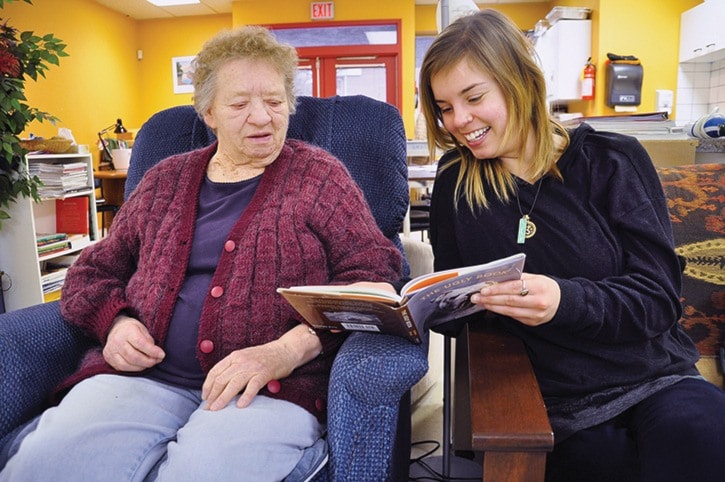With The Beatles piped into her headphones and a paintbrush in hand, 52-year-old Cindy Walsh dabs watercolours onto her latest work in the Garth Homer Centre.
Behind her, Dolores Wilkinson, 79, peruses a book of funny animals with community services worker Alison Webb. Standard morning activities for the day centre for adults with developmental disabilities.
Only a few decades ago Wilkinson and Walsh would have been a rare breed – the life expectancy of people with Down syndrome and other cognitive impairments was considerably lower than the general population.
But they are members of the first cohort in history of developmentally disabled adults reaching their senior years in large numbers, a phenomenon that is forcing the provincial government to rethink how it cares for a population that is aging and intensely vulnerable.
“Now we are into the first generation of people with developmental disabilities who are getting old,” says Mitchell Temkin, CEO of the Garth Homer Society. “We believe community inclusion and acceptance has helped life span increase. It’s a baby boomer generation … and there’s lots of them.”
The Garth Homer Centre, for one, is trying to take a leadership role in how service providers adjust to the wave of aging adults that is yet to be accounted for through government funding.
Now with 30-plus clients between age 50 and 80 in day programs, last May the centre hired Phemie Guttin, a registered nurse, as its first director of geriatric services.
“I suspect the number of (senior) clients will grow quickly,” Guttin says. “This is happening in a lot of sites. We never had a significant number before, it wasn’t on the radar.”
Much like the regular population of adult clients, senior clients engage in art, reading and writing, cooking, a drama program and music therapy – programs to keep them mentally and physically engaged.
Cognitively disabled people age like anyone else – they become frail, medical costs go up and some, especially people with Down syndrome, get early onset dementia.
As their clients age, Garth Homer staff, caregivers and the facility will need training on caring for the elderly and the infrastructure to match, but it’s not clear where the money will come from.
Temkin says developmentally disabled people reaching old age has presented a quandary for government – agencies like Garth Homer are funded to deal with disabilities and not with geriatrics, while the health care system doesn’t pay for people with disabilities.
A simmering problem is that perhaps a quarter of disabled people in B.C. are cared for by their parents at home, but those parents too are part of the grey wave of retiring baby boomers.
“Kids are aging as parents are aging. If you’re the sole support and you reach an age where you can’t care anymore, it’s a scary place to be as a parent,” Temkin says. “What happens when (the disabled person) is 60 and their parents are 85? Informal arrangements start falling apart.
“It’s a big problem and there is a policy vacuum,” he adds. “When the system was created, nobody thought about people getting old.”
Community Living B.C. (CLBC), the Crown agency which provides funds and services for people with developmental disabilities, is projecting it will see 300 clients each year for the next four years reach age 55 and older, adding to the thousands that exist now.
A government review of CLBC in 2011 laid out a “12 point” plan to improve service for its clients, including creating an aging client strategy. The plan offered $144 million in new funding to meet demands of an overall growing client load.
“Everyone recognizes that (funding) won’t meet the full demand,” said David Hurford, spokesperson for CLBC. “A gap is there with respect to demand, but the government said more funding is coming with the implementation of the 12 point plan.”
The set of plans for CLBC is expected to be rolled out in upcoming months, Hurford said, which includes an aging strategy and funding protocols between the Ministry of Health and Ministry of Social Development.
A key component for the CLBC aging strategy is developing a care plan with families and parents to ensure their disabled adult child has clear continuity of support.
“Families looking after children have to worry about their mom and dad aging. It is a two-fold issue,” Hurford says. “If mom and dad become frail, we provide the supports to individuals and their aging parents.
“The key is to get in early and talk. The key is to approach families and ask what they want, and how to facilitate what they want. We don’t come at them with a program.”
Hurford says the issue of aging clients has been on the CLBC’s radar for about five years, but it was the accidental death of a 76-year-old client in the West Shore in 2011 that prompted a deep review of its services for seniors. The B.C. Coroners Service made a number of recommendations to improve the safety of seniors within CLBC programs.
“That situation required a close look at aging people in CLBC care. It was a turning point for us,” Hurford said.
Meanwhile, Temkin said the Garth Homer Society will present the government with funding models that could give service providers more flexibility on how they adapt to aging clients.
“The demographic is changing and there is need for a support and a funding model that isn’t there,” he says.
“It will take years to sort out (provincial funding), in the meantime people don’t stop getting old while the government figures out priorities of the system.”
editor@saanichnews.com
